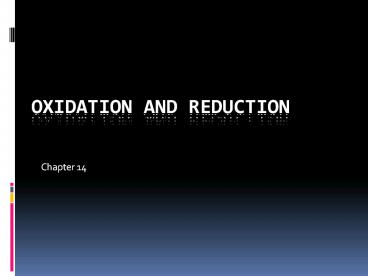Oxidation and Reduction - PowerPoint PPT Presentation
1 / 14
Title:
Oxidation and Reduction
Description:
Chapter 14 Oxidation and Reduction Oxidation - addition of Oxygen. Reduction - removal of Oxygen. In terms of electrons Oxidation is the loss of electrons. – PowerPoint PPT presentation
Number of Views:178
Avg rating:3.0/5.0
Title: Oxidation and Reduction
1
Oxidation and Reduction
- Chapter 14
2
Oxidation and Reduction
- Oxidation - addition of Oxygen.
- Reduction - removal of Oxygen.
- In terms of electrons
- Oxidation is the loss of electrons.
(OILRIG) - Reduction is the gain of electrons
3
Oxidising and reducing agents
- An oxidising agent causes another substance to
become oxidised and, in the process, the
oxidising agent is reduced. Common oxidising
agents include O2, Cl2, ClO-, KMnO4 and H2O2 - A reducing agent causes another substance to
become reduced and, in the process, the reducing
agent is oxidised. Common reducing agents include
CO, SO2, SO32- - Oxidising agents are useful in Sterilising and
Bleaching.
4
Experiments (a) Halogens as Oxidising agents
(b) Displacement
reactions of Metals. (See Book Pages 184-186)
5
Oxidation Numbers
- The oxidation number of an atom is the charge
that the atom has or appears to have when
electrons are distributed according to certain
rule. - Rules
- The ON of an element is 0.
- The ON of an ion is the charge that it has.
- The ON of F is always -1.
- The ON of O IS -2 except OF2 (2) and H2O2 (-1).
- The ON of H is 1 except with metal hydrides (-1)
6
Oxidation and reduction in terms of Oxidation
numbers
- Oxidation is an increase in Oxidation number.
- Reduction is a decrease in Oxidation number.
- Balancing Redox reactions (See Book Page 187-188)
HANDOUT
7
2.6.2Balancing equations using Oxidation
Numbers
8
- Chemical reactions are all about the movement of
electrons - When an equation is balanced the electron
movements must balance - Sometimes it is possible to balance an equation
in more than one way - It is therefore possible to make the numbers of
atoms balance but not the electron movement - Using oxidation numbers prevents this
9
Sequence of events
- Write out the formulae of all reactants and
products - Assign oxidation numbers to all atoms
- Pick out the atoms whose oxidation numbers change
- Write down the electron movements
- Balance the electron movements
- Enter the numbers from balanced electron movement
into the overall equation - Balance equation by inspection - do H last
10
1. Assign oxidation numbers
- (a) Assign Oxidation increase in Ox. No
- (b) Assign Reduction decrease in Ox. No
2. Select those which change
5
5
4
8
- MnO4- Fe2 H Mn2 Fe3 H2O
- 7 -2 2 1 2 3
1 -2
7
2
2
3
Oxidation
Reduction
5. Write electron gains and losses
6. Balance electron transfers
Fe2 Fe3 2 3
5
5
- 1 e-
5
Mn Mn2 7 2
5 e-
7. Put numbers up into the equation
8. Balance equation by inspection - leave H
till last
11
Sequence of events
- Write down reactants and products
- Assign oxidation numbers
- Identify oxidation and reduction
- Write down changes and electrons involves
- Balance e- change
- Put changes into equation
- Balance equation by inspection H last
12
1. Assign oxidation numbers
- (a) Assign Oxidation increase in Ox. No
- (b) Assign Reduction decrease in Ox. No
2. Select those which change
- C2H5OH Cr2O72- H CH3COOH Cr3
H2O - -2 1-21 6 -2 1 0
1 0 -2-21 3 1-2
3
3
4
2
11
16
-2
3
0
6
0
Reduction
Oxidation
5. Write electron gains and losses
6. Balance electron transfers
3
3
4
12
x3
C2 C2 -2
0
- 2 e-
x2
2
4
Cr2O72- Cr3 6
3
2
3 e-
6
12
7. Put numbers up into the equation
- Balance equation by inspection - leave H till
last - O 3(27) (32) x ? x11 -
H ? 3(61) X (34)
11(21) ? x 16
13
Examples
- C2H5OH MnO41- H CH3CHO Mn2 H2O
- C2H5OH MnO41- H CH3COOH Mn2 H2O
- Cr2O72- Fe2 H Cr3 Fe3 H2O
- MnO41- C2O42- H CO2 Mn2 H2O
- Fe2 Cl2 Fe3 Cl-
- MnO41- H2O2 H Mn2 O2 H2O
- Cr2O72- CH3OH H Cr3 HCHO H2O
- Cr2O72- CH3CHO H Cr3 CH3COOH H2O
14
Answers
- 5C2H5OH 2MnO41- 6H 5CH3CHO 2Mn2 8H2O
- 5C2H5OH 4MnO41- 12H 5CH3COOH 4Mn2
11H2O - Cr2O72- 6Fe2 14H 2Cr3 6Fe3 7H2O
- 2MnO41- 5C2O42- 16H 10CO2 2Mn2 8H2O
- 2Fe2 Cl2 2Fe3 2Cl-
- 2MnO41- 5H2O2 8H 2Mn2 5O2 8H2O
- Cr2O72- CH3OH H Cr3 HCHO H2O
- Cr2O72- CH3CHO H Cr3 CH3COOH H2O































